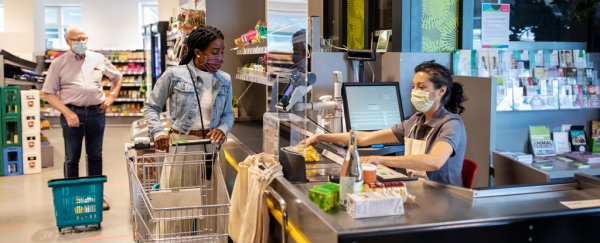As the pandemic marches on, many people have taken solace in the idea that as long as we keep our interactions with others brief, our coronavirus risk will remain low.
But new research from the Centres for Disease Control and Prevention found that people can get sick after spending very brief moments near people with COVID-19. The findings led the agency on Wednesday to update its guidelines about what to do if you're exposed to someone with the coronavirus.
The agency still says that people must quarantine if they have been in close contact with someone who tests positive for the coronavirus. But previously, that close contact was defined as being within 6 feet of an infected person for more than 15 minutes anytime starting two days before that person feels sick. The new CDC language, however, now says it's cumulative exposure that matters, not continuous time.
The new guideline, which informs how health agencies conduct contact tracing, now stipulates that anyone who has been within 6 feet of an infected person "for a total of 15 minutes or more over a 24-hour period," should quarantine.
The change came after a CDC study found that a correctional officer got sick after a series of brief encounters with inmates who later tested positive for COVID-19. During his 8-hour shift at a Vermont correctional facility, the officer had 22 interactions with the inmates, each less than a minute long, for a total of 17 minutes of exposure to infected people.
Together, that was enough for the officer to catch the coronavirus.
"This change underscores the importance of vigilant social distancing even multiple, brief interactions can pose a risk," Caitlin Rivers, an epidemiologist at the Johns Hopkins Centre for Health Security who was not involved in the study, told The Washington Post.
A total of 15 minutes or more over a 24-hour period
Using video footage from the correctional officer's 22 encounters during his shift on July 28, CDC researchers were able to tabulate how many minutes, in total, he had been exposed to six inmates whose COVID-19 test results came back positive the following day.
The 20-year-old officer never spent 15 consecutive minutes within 6 feet of any inmate, but his "numerous brief (approximately 1-minute) encounters" cumulatively exceeded 15 minutes, the study authors reported.
The inmates were asymptomatic during the officer's shift, yet still transmitted the coronavirus during these encounters, the researchers wrote, adding that "public health officials should consider transmission-risk implications of cumulative exposure time" within correctional facilities.
The officer started showing coronavirus symptoms on August 4, including loss of smell and taste, a runny nose, cough, shortness of breath, and headaches. He stayed home from work the next day, but because he hadn't met the CDC's definition of close contact, he'd worked the entire week between his exposure and the start of his symptoms. During that time, he unknowingly put his coworkers and other inmates at risk.
The new change to the CDC's close contact guidance is meant to prevent similar situations in the future.
"As we get more data and understand the science of COVID, we're going to incorporate that into our recommendations," CDC director Robert Redfield said during a Wednesday briefing.
This new tweak to the guidance, he added, is "based on data that one didn't have four months ago."
The inmates didn't wear masks during every encounter
The correctional officer wore personal protective equipment when he interacted with the asymptomatic inmates: He had a cloth mask, grown, and eye protection on the entire time, and gloves most of the time.
The inmates wore masks when they encountered the officer outside their cells, but the study found that the inmates were maskless during several encounters in cell doorways or in the recreation room.
Face coverings can prevent coronavirus transmission, so this case study further underscores the importance of wearing a mask even during brief encounters, a CDC spokesperson said Wednesday.
The new findings and resulting guidance change will impact future contact-tracing work, according to Rivers.
"It's easy to accumulate 15 minutes in small increments when you spend all day together, a few minutes at the water cooler, a few minutes in the elevator, and so on," she told The Washington Post. "I expect this will result in many more people being identified as close contacts."
Aria Bendix contributed reporting to this story.
This article was originally published by Business Insider.
More from Business Insider:
